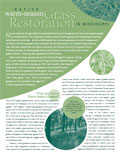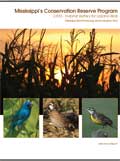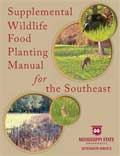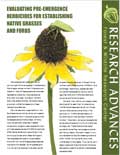Game Animals
Non-game Animals
Habitat
Native Grasses
- Include annual and perennial grasses native to area
- Provide wildlife habitat, livestock forage, reduce erosion, and improve water quality
- Many assistance and cost-share programs available for planting and managing native grasses
Habitat Description: Native Grasses
Native warm-season grasses are annual and perennial grasses historically native to an area. Once abundant in Mississippi, they grow primarily during the summer months and include species such as little bluestem, big bluestem, switchgrass, Indian grass, broomsedge and eastern gamagrass. Most of the native warm-season grass prairies have been converted to agricultural land and in landscapes, these grasses have been largely replaced by non-native forage grasses.
Restoration of native warm-season grasses can be beneficial to landowners. Native warm-season grasses provide habitat for wildlife such as bobwhite quail, grassland songbirds and butterflies. They also provide quality livestock forage during the summer. These grasses play an important role in ecosystem restoration. For example, they can help restore prairies, oak woodland savannahs and pine woodland savannahs.
Landowners can reap the benefits of native warm-season grasses by restoring them in either large acreages or in portions of agricultural fields, such as in buffers along field edges. With proper management, they will increase small game habitat and provide plentiful forage.

Native Warm-Season Grass Restoration in Mississippi (PDF)
Mississippi State University Forest and Wildlife Research Center
This publication defines native warm season grasses, lists examples of the types of warm season grasses and provides labeled drawings of the types. It describes the benefits of restoring native grasses and how to do so. Information is provided on keeping different non-native grass species under control. Information is also given on choosing and planting grass species in a way that restores ecosystems and is advantageous to wildlife or creates livestock forage. Use of periodic disturbances is also covered along with contact information for organizations that assist with management of warm season grasses.

Mississippi's Conservation Reserve Program CP33 (PDF)
Mississippi State University, Natural Resources Conservation Service, Mississippi Department of Wildlife, Fisheries and Parks, USDA Farm Service Agency, Forest and Wildlife Research Center
CP33 field borders or habitat buffers are designed to benefit quail and other grassland bird populations. A research program was initiated in 2006 to study the effects of CP33 native grass habitat buffers on bird populations in Mississippi. The results of this study are presented in this report.

Supplemental Wildlife Food Planting Manual for the Southeast (PDF)
Mississippi State University Extension Service
This guide provides information on food plots and habitat management practices including disking, mowing and prescribed burning. The importance of openings is also discussed. A combination of supplemental forages in food planting is often necessary, as well as testing soil quality, fertilizing and liming. The location, size and shape of food plots as well as how to prepare them and which plants to use is included. An extensive guide on planting materials is given.

Evaluating Pre-emergence Herbicides for Establishing Native Grasses and Forbs (PDF)
Mississippi State University Forest and Wildlife Research Center
Native warm-season grasses are important habitat for many birds, pollinators, and other wildlife. To increase this habitat, many programs and organizations are promoting planting native warm-season grasses. Failure of these grasses is often due to competition from weeds. This research investigated the use of application rates of pre-emergence herbicide on success of warm-season grasses.
Native Warm-Season Perennial Grasses for Forage in Kentucky (PDF)
University of Kentucky, College of Agriculture
Warm-season grasses grow best in summer and late spring. These grasses are well-adapted for Kentucky's climate and soils. This publication covers the grass species suited to Kentucky, how to establish these grasses, and managing grasses.
Warm-Season Grasses and Wildlife (PDF)
Pennsylvania State University
Grassland habitats have declined in Pennsylvania, meaning the species using these habitats are also declining. Planting warm-season native grasses can improve bird habitat. Once established, warm-season grasses require little maintenance. This publication discusses the types of grasses native to Pennsylvania, the wildlife species that use this habitat, how to establish native grasses, controlling weeds, and how to maintain native warm-season grasses.
Growing Warm Season Grasses in Connecticut (PDF)
University of Connecticut Soil Nutrient Analysis Laboratory
Warm-season grasses that can be planted in Connecticut are covered in detail. This publication discusses seeding warm season grasses, recommends testing the soil, and discusses the maintenance required to control competition from weeds.
Grasses and Forbs for Wildlife: Fall and Winter Food Plots (PDF)
University of Arkansas Cooperative Extension Service
Planting year-round food plots provides food, cover, nesting, and roosting sites for wildlife. Establishing a diversity of plants is key. Native forbs and grasses are important, but sometimes managing native plants may not be an option. This guide provides recommendations for native warm-season grasses and other grasses and forbs to be used for food plots.
Warm Season Grass Establishment (PDF)
Indiana Division of Fish and Wildlife
Grasslands are beneficial to songbirds, game birds, small mammals, reptiles, and insects. Wildlife prefer open grasslands with a high concentration of forbs, especially legumes. This publication covers seed selection, field layout, seed bed preparation, use and selection of herbicides, incorporating forbs and legumes, planting, and maintenance.

